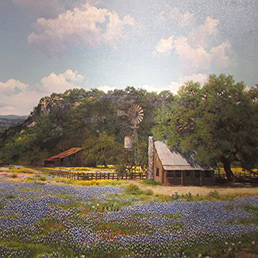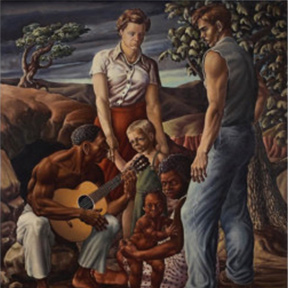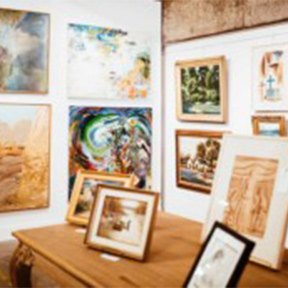- (214) 720-4044
- info@daviddike.com
- Mon - Fri: 10 am - 5 pm
Benrimo, Thomas
Thomas Benrimo
(Am. 1887-1958)
Born in San Francisco in 1887, Thomas Benrimo began to draw at a young age, but the San Francisco earthquake and fire of 1906 destroyed his early drawings and notebooks and forced the family to move to New York.
Despite suffering from tuberculosis, Benrimo recovered and became a successful stage designer and commercial artist in New York. He painted seriously whenever he could, but only a few of the Cubist paintings of this early period survive. Benrimo taught at Pratt Institute and was one of the first in this country to introduce the teaching methods developed at the German Bauhaus School of design.
Benrimo moved to Taos, New Mexico, in 1939, and was able at last to paint full-time. His work evolved through periods of Cubism and Surrealism and pure abstraction, often showing influences of antiquity, traditional painting and architecture, yet the artist believed, as he had once observed, that “abstract art departs from reality and nature only to draw far-reaching conclusions about reality. A legitimate abstract work of art can be produced only on the basis of a profound knowledge of nature.” Benrimo was influenced by the landscape of New Mexico but not chained or restricted by it.
As Benrimo gradually worked from the surreal to the more abstract, he explored a series of classic images based often on Greek tragic masks. In a Canfield Gallery exhibition catalogue, the New Mexico artist Earl Stroh writes: “The greater formal discipline of classic motifs, based on themes from the literature of Greece and Rome (he read and reread the Greek and Latin poets and dramatistsVirgil, Ovid, etc.) on an acute absorption of the visual ideas of Mediterranean art, helped him to free himself from the more literal rendering of his ideas and to achieve that lyric, almost romantic, exactness that gives his finest work its contained clarity. It is mostly this particular combination of the romantic and the classic modes of feeling that gives his art its unique quality. One of the principal things that really creative art contributes to our lives is some new vision of the marriage of what are, until that moment, considered as opposites. This union of contrasts, both formal and significant, occupied him greatly.”
During his life, Benrimo’s work was shown at the Art Institute of Chicago, Toledo Museum of Art, Carnegie Institute of Pittsburgh, San Francisco Palace of the Legion of Honor, Whitney Museum of American Art, Musée National d’Art Moderne in Paris, Guggenheim Museum in New York, San Francisco Museum of Art, and the Museum of Modern Art in New York.
Benrimo paintings are in the permanent collections of the Cincinnati Museum of Art, Denver Art Museum, Fort Worth Museum of Modern of Art, and the Whitney Museum of Art. In New Mexico, Benrimo’s work is in the Harwood Museum, Taos; Wurlitzer Foundation, Taos; University of New Mexico Museum of Art, Albuquerque; Roswell Museum and Art Center, and the Fine Arts Museum in Santa Fe.





